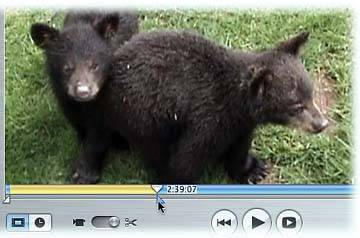Tip: Here's a quick trick for highlighting only the first portion of a selected clip: Shift-click within the Scrubber bar at the point where you'd like the selection to end . Instantly, iMovie highlights everything from the left end of the clip to the position of your click.
After you've just dragged or clicked a handle, your arrow key skills come in extremely handy. You can let go of the mouse and, just by pressing the left and right arrow keys, fine-tune the position of the triangle handle on a frame-by-frame basis. (You can tell which triangle handle you'll be moving. It's darker , and it's marked by the Playhead, as shown in Figure 14-4. To move the other triangle handle, click it first.) Continue tapping the left and right arrow keys until the Monitor shows the precise frame you wantthe first or last frame you'll want to keep in the clip.
Remember, too, that if you press Shift -right or-left arrow, you move the triangle handle 10 frames at a time. Between the 10-frame and one-frame keystrokes, you should find it fairly easy to home in on the exact frame where you want to trim the clip.
Tip: After you've highlighted a stretch of the Scrubber bar, you can adjust the selected portionmake it bigger or smallerby clicking or dragging again beneath any unhighlighted portion of the Scrubber bar (to the right or left of the selected region). Either way, the end of the yellow bar jumps to your cursor as though attracted by a magnet . And either way, you avoid having to redo the entire selection, since one of your two endpoints remains in place.
As you drag the triangle handles, keep your eye on two readouts. First, your precise position within the clip or assembled movie appears just above your cursor, in seconds:frames format.
Second, a notation appears beneath the Movie Track that identifies the amount of footage between the handles. It might say, for example, "Frames selected 0:03:15 of 6:00:02 total." That is, you've selected 3.5 seconds of a 6-minute movie.
Being able to see exactly how much footage you're about to cut (or preserve) can be extremely useful when the timing of your movie is important, as when editing it to accompany a music track or when creating a movie that must be, for example, exactly 30 seconds long.
Tip: If you've really made a mess of your selection, click just below the Scrubber bar, on the brushed aluminum iMovie background. The program deselects your footage so that you can try again.
14.5.2. Snipping Off One End of a Clip
Having mastered the art of selecting a portion of a clip, as described in the previous section, you're ready to put it to work. Suppose, for example, that you want to shave off some footage from only one end of your clip. In that case, highlight the footage you want to delete (at the beginning or end of the Scrubber bar), and then choose Edit  Cut (or Edit
Cut (or Edit  Clear), or press the Delete key.
Clear), or press the Delete key.
iMovie promptly trims away whatever was highlighted between the triangles. The arrangement should look like Figure 14-5.
 | Figure 14-5. To trim footage from one end of the clip, just highlight that much, using the triangle handles. The Monitor window shows you where you are in the footage as you drag the triangles. And once again, you can use the arrow keys to fine-tune the position of the triangle you've most recently clicked. | |
14.5.3. Cropping Out the Ends of a Clip
If you want to trim some footage off both ends of a clip, it's quicker to highlight the part in the middle that you want to keep . Just select the footage you want to preserve and then choose Edit  Crop (or press -K). What used to be the yellow part of the Scrubber bar has now, in effect, expanded to fill the entire Scrubber bar. Your clip is shorter now, as a tap on the Space bar will prove .
Crop (or press -K). What used to be the yellow part of the Scrubber bar has now, in effect, expanded to fill the entire Scrubber bar. Your clip is shorter now, as a tap on the Space bar will prove .
14.5.4. Chopping Out the Middle of a Clip
In this technique, you eliminate the middle part of a clip, leaving only the ends of it in your project. Select the footage you want to delete, and then choose Edit  Cut (or Edit
Cut (or Edit  Clear), or press the Delete key.
Clear), or press the Delete key.
If you're not prepared for it, the results of this technique can be startlingand yet it's perfectly logical. If you cut a chunk out of the middle of the clip, iMovie has no choice but to throw back at you the two end pieces as two separate clips, side by side on the Clips pane or the Movie Track. Either way, the name of the newly created clip will help you identify it. If the original clip was called "Cut Me Out," the new, split-off clip is called "Cut Me Out/1."

 Crop command, everything outside of these handles is trimmed away.
Crop command, everything outside of these handles is trimmed away. 